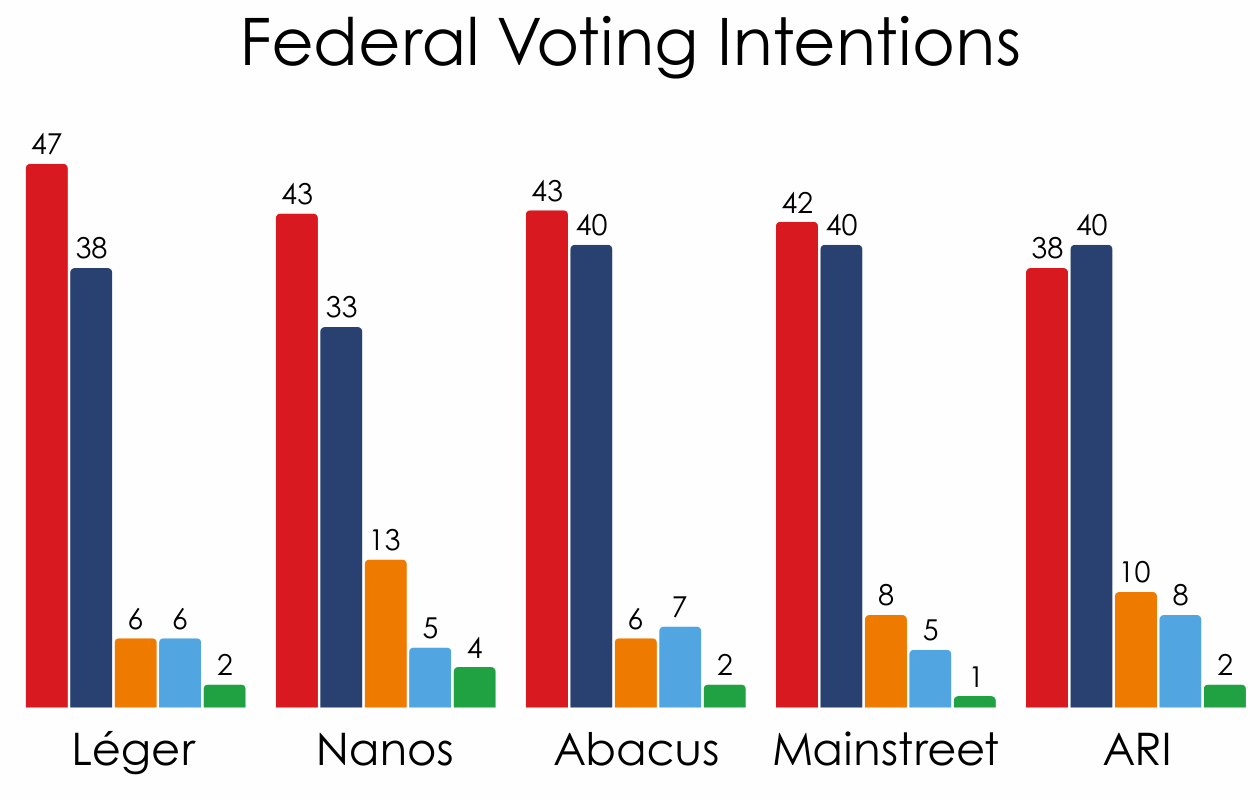Weekly Writ 9/11: 3 takeaways from the polls as Parliament returns
Plus, we get a glimpse of just how much money the Conservatives spent on advertising in the 2025 campaign (it's a lot).
Welcome to the Weekly Writ, a round-up of the latest federal and provincial polls, election news and political history that lands in your inbox every Thursday morning.
With the return of Parliament on Monday, there has been a flurry of polls published over the last week. Those polls don’t all tell the same story, but there are a few conclusions we can draw from the numbers as this political season is about to begin.
The polls come from Léger, Nanos Research, Abacus Data, Mainstreet Research and the Angus Reid Institute. They show voting intentions ranging from a 10-point Liberal lead to a small two-point Conservative advantage.
The Liberals have between 38% and 47% support in these polls, with the Conservatives between 33% and 40% and the New Democrats between 6% and 13%. Considering the margins of error, these ranges are not entirely unreasonable, even if the narratives they produce can be wildly different — one set of polls suggests not much has changed since the last election, or even that the Liberals have lost a little ground. The other set suggests the Liberals’ are in a better position than they were in April, thanks in part to a Conservative decline.
It’s the kind of choose-your-own-adventure that partisans love (and hate).
But, looking at these five polls together, I see three major takeaways that forms more of a consensus view of these surveys:
Voting intentions trend unclear, but Liberals hold the advantage
There is no real trend across these five polls. Léger has shown no movement over the summer, with the Liberals going from 48% to 46% to 47%. The Conservatives have ticked upwards from 35% in early July. But Abacus has the Liberals up four points from their last poll and the three-point gap is as wide as Abacus has shown the race throughout the summer. Nanos has record a Liberal lead of around 10 points for some time, while these are the first numbers we’ve seen from ARI since the election, and only the second poll from Mainstreet. There’s no obvious trend.
The Liberals hold an average lead of four points across these polls, similar to the lead they held at the end of the election campaign. This suggests the Liberals would still be greatly favoured to win re-election if a vote was held today, but not necessarily that they are any closer to securing a majority government.
Mark Carney is trending down, but his numbers are still good
One trend that is plain to see is a drop in satisfaction with Mark Carney and his government. Since early July, both Léger and Abacus have satisfaction or approval of the government down four points, with dissatisfaction or disapproval up five points.
Carney’s personal approval or positive ratings have dropped either three points (Abacus and Léger) or five points (ARI) since early August, while his disapproval or negative ratings have increased by between three and seven points.
Though his numbers have worsened, they are still very good for a sitting prime minister. Both Léger (53%) and the ARI (51%) have majority approval for Carney, while Abacus shows 45% of Canadians holding a positive impression of him. His net approval/disapproval or positive/negative scores average +13 points across these three polls.
Pierre Poilievre still has some problems
Carney’s sliding personal numbers have not coincided with improving fortunes for the Conservative leader. According to Léger, only 36% of Canadians think Pierre Poilievre has a “good chance” of beating Carney in the next election. Nearly one-in-five Conservative voters doubt that Poilievre has what it takes.
Abacus continues to show no improvement in Poilievre’s personal numbers, with his positive/negative rating being a net -3. He’s a net -10 in the suburbs. The ARI has Poilievre’s unfavourability increasing to 58%, the highest its been.
One small morsel of good news for him is that Nanos has Poilievre increasing to 28% on its preferred prime minister measure. But that still puts him 22 points behind Carney.
These numbers put the onus on both Mark Carney and Pierre Poilievre to deliver this fall. Some cracks are beginning to show in Carney’s facade. Can he patch them up before any structural damage becomes permanent?
For Poilievre, the theory that the Liberals will inevitably falter and that the Conservatives will win by default if only they hold onto their own support base will be tested. Poilievre’s chances of winning the next election are not solely dependent on the popularity of the Liberals. His own unpopularity was one of the factors that depressed the NDP vote and made Carney the more palatable choice in a binary race. Even if Carney’s numbers deteriorate further, he can remain that better option if Poilievre’s numbers slide, too.
Here’s what’s in this instalment of the Weekly Writ:
News on how much money the Conservatives spent in the last election campaign and of an upcoming provincial byelection in New Brunswick. Plus, the NDP finished 2024 in the black, the CAQ has lost a couple of MNAs and the Manitoba Liberals have gained a potential new leader.
Polls show François Legault’s popularity is scrapping the bottom of the barrel, but he’s not alone among the premiers who had a tough summer. Plus, we have polls on how Canadians view the temporary foreign workers program and which national projects would have the biggest impact, as well as how Montrealers view their upcoming mayoral race and how Ontarians view Bonnie Crombie’s leadership.
#EveryElectionProject: Gary Filmon calls an early Manitoba election in 1990.
Upcoming milestone for Wab Kinew.
NEWS AND ANALYSIS
Conservatives spent $23 million on campaign ads
The Conservatives went all-in on television ads during the last election campaign, spending more than half of their total $23 million advertising spend on TV.



